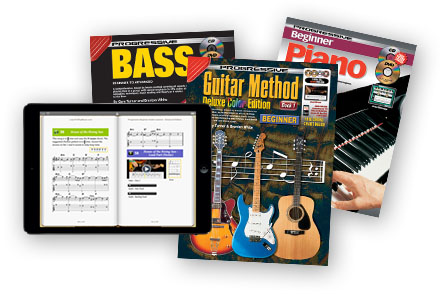<< First < Previous | Intro 1 2 3 4 5 6 7 8 9 10 11 12 13 14 15 16 17 18 19 20 A | Next > Last >>
Back to Table of Contents
How To Read Sheet Music
Most of the sheet music you will buy will be arranged for piano. Piano music is written using two or three staves, with the chord symbols written above the top staff. It may also contain unfamiliar symbols and terms. At this stage you need only look at the top staff, which contains the melody line (tune), the lyrics and the chords. In some sheet music, chord diagrams may also be included. As most sheet music is arranged by keyboard players there are often no ukulele chord shapes, or there may be guitar chord shapes present.
Also many piano arrangements are in difficult keys for a beginning ukulele player and can use unnecessary chords. Piano sheet music also gives no indication of how to strum the chords. Therefore piano sheet music is only a guide for a uke player and is useful for lyrics and as a general chord guide.
If the song contains chords that you are not familiar with you can:
- Learn how to play this new chord.
Refer to the chord chart in the following section. - Substitute an easier chord.
Use the following easy chord table which lists the type of chord you may see in the sheet music (on the left of the table) and the simpler chord you can substitute (on the right of the table). If you know how to transpose and substitute chords you can play almost every song ever written using only a few basic chord shapes. - Change the key of the song.
Transposing (or Transposition) is the process of changing a song or piece of music from one key to another.
There are two reasons for transposing into another key:
- If the song is too high or too low to sing, the song can be changed into a lower or higher key. Changing the key of a song does not change the sound, pattern or timing of the melody but simply changes how high or how low it is sung.
- If the song is hard to play or contains difficult chords you can transpose it to a key with easier chords. For example, if a song is written in the key of B
 (which many songs are) it would contain chords like B
(which many songs are) it would contain chords like B  , E
, E  and Cm which may be difficult for a beginner. If the song is transposed into the key of G major the chords would then be G, C and Am, which are easier to play on the ukulele.
and Cm which may be difficult for a beginner. If the song is transposed into the key of G major the chords would then be G, C and Am, which are easier to play on the ukulele.
How To Transpose
If the sheet music is in the key of E flat (E  ) major and contains difficult chord shapes, you can transpose it to another major key with easier chord shapes. Keys that contain easy shapes for beginners are C major and G major, or if the song is in a minor key, A minor (Am) or E minor (Em).
) major and contains difficult chord shapes, you can transpose it to another major key with easier chord shapes. Keys that contain easy shapes for beginners are C major and G major, or if the song is in a minor key, A minor (Am) or E minor (Em).
Write down the chromatic scale (see the following diagram) of the key the sheet music is in (usually the first chord is the key chord). Then underneath it write down the chromatic scale of the key you wish to change to. For example, to change a song from the key of E  to the key of G, write down the chromatic scale starting with the note E
to the key of G, write down the chromatic scale starting with the note E  and then underneath it write down the chromatic scale starting on the note G.
and then underneath it write down the chromatic scale starting on the note G.
The letter name of the chord is written on the top line and the letter name of the new chord in the new key (in this case G) will be directly underneath it.
Note that the chord type never changes. If the chord is a minor chord in the key of E  major it will also be a minor chord in the major key it is transposed to.
major it will also be a minor chord in the major key it is transposed to.
e.g., an E  chord in the key of E
chord in the key of E  major becomes a G chord in the key of G major.
major becomes a G chord in the key of G major.
e.g., an A  chord in the key of E
chord in the key of E  major becomes a C chord in the key of G major.
major becomes a C chord in the key of G major.
e.g., an Cm chord in the key of E  major becomes an Em chord in the key of G major.
major becomes an Em chord in the key of G major.
e.g., a B  m chord in the key of E
m chord in the key of E  major becomes a Dm chord in the key of G major.
major becomes a Dm chord in the key of G major.
The easiest keys for ukulele are:
G major, C major, D major, A major, E major, A minor and E minor. These keys contain chords that have open strings in them, which are generally easier to hold.
Chord Chart
The following diagrams show open chords for ukulele. Open chords are commonly found in sheet music, and they sound great on this instrument.
Tuning To Another Instrument
If you are playing along with another instrument, it is essential that your ukulele be in tune with that instrument. Tune the open strings of your ukulele to the corresponding notes of the accompanying instrument. E.g., to tune to a piano, tune the open 4th string to the G note on the piano, as shown on the keyboard diagram. Then tune your ukulele to itself from this note using the method outlined next, or tune each string of your ukulele to those notes of the piano shown on the keyboard diagram.
Tuning The Ukulele To Itself
Unless you are using an electronic tuner, to be able to tune the ukulele accurately usually requires many months of practice. You will probably need your music teacher or musician friend to help you tune when you are learning.
If you do not have another instrument to tune to, you can tune the ukulele to itself by using the following method.
- Tune the open 4th string (a G note) to a pitch pipe or another instrument. If these options are not available then tune the string to a familiar pitch and assume the string is in tune.
- Tune the open 1st string (an A note) to the same pitch as the second fret of the 4th string.
- Tune the 2nd string until the note on the third fret of the 2nd string (a G note) is the same pitch as the open 4th string.
- Tune the 3rd string until the note on the fourth fret of the 3rd string (an E note) is the same pitch as the open 2nd string.
<< First < Previous | Intro 1 2 3 4 5 6 7 8 9 10 11 12 13 14 15 16 17 18 19 20 A | Next > Last >>
Back to Table of Contents













































































































